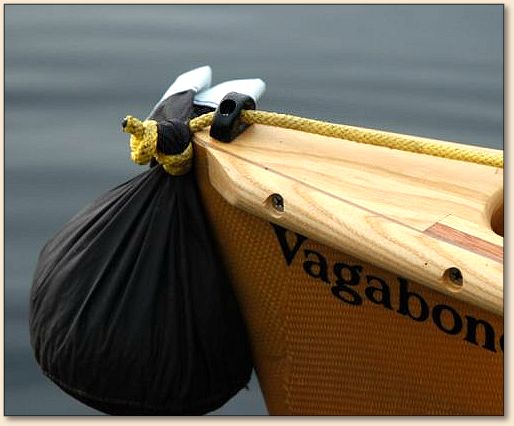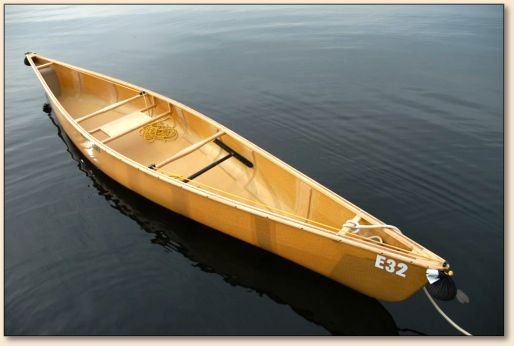|
Last fall I got a personal email from FAOL reader Alex
Lee, a fly fisher who informed me that he recently bought
a new solo canoe. Alex had just finished outfitting
his new boat with essentially the same 2-anchor system I
installed on my canoe – the anchoring system I finally
succeeded in piecing together a while back after years
of trial and error conceptualizing. (See "2-Anchor System
Parts 1 &
2", in FAOL's
Warm Water Archive.)
I say "essentially the same" because although his system
functions like the one I devised (exploiting gravity and
normal boat motion to operate just two simple mechanical
devices), Alex's system uses components of a type that I
feel are more practical, more attractive and easier to
install – and not just easier to install on Alex's canoe
but easier to install on a wide range of canoe models.
(Possibly on kayaks as well, but kayakers will have to
evaluate that themselves.)
The components I'm talking about are the fairleads.
Looking at the attached photos in his email, I appreciated
immediately that Alex's choice of fairleads is light years
better than the crude U-bolts I pressed into service on my
canoe.
For those not familiar with the term, a "fairlead" is a
nautical fitting through which a line passes. When installed
on the end of a canoe as part of my anchoring system, a
fairlead functions like the tip-top guide on a fishing rod.
The fairlead physically restricts within a very small area
the movement of your outgoing and incoming anchor line.
The fairlead allows no lateral motion; your anchor line
slides in and out only while coming off the exact end of
your boat.
Alex didn't say, but I surmise, that he's spent considerable
time around more kinds of watercraft than I have, thus he's
more familiar with marine hardware items and their uses.
Whether that's true, the fact remains that when Alex's
email arrived I clicked on the web sites he gave me and
instantly I spotted not one but two kinds of fairleads
that I would have happily installed on my canoe instead
of the U-bolts I ended up using. (U-bolts can properly
be called "home and garden fittings" whereas the fairleads
Alex showed me are clearly "marine fittings.")
Again, like in the second of the two stories I wrote last
year describing the 2-anchor system, my intent in giving
you the web link to a commercial site (below) is not to
show favoritism to this equipment supplier. Rather, it
is to give you a quick link that lets you study different
fairleads and learn their correct names. That way you can
either purchase these devices quickly from this supplier,
or conduct a faster search elsewhere with other suppliers
once you've learned the proper name of the device you wish
to buy.
So...here is the web link address to
West Marine. This shop is where Alex Lee bought his fairleads.
Okay, so far so good.
Alex in his email told me that he has another canoe,
and on this older boat he had been using a type of deck
fitting called a "Fairlead eye strap." This device is
exactly what I wanted to install on my canoe ends a couple
of years ago, and would have installed had I been able to
find them. Maybe I could have found them if I'd only known
what they are called in nautical terminology. But I didn't
know.
While conceptualizing the 2-anchor system, in my mind's
eye I could see the basic shape of the deck fittings I
needed, but once I began through my local hardware stores
I couldn't find anything remotely like it. That's why I
settled on common U-bolts as my anchor line fairleads: any
solution would do so long as it finally got my butt – er,
my boat – anchored stationary out there where the panfish
are.
Here's West Marine's selection of
fairlead eye straps. These are metal fairleads. Click
on the link and take your pick; there's a bunch of 'em.
Once he bought his new canoe, Alex decided to install my
2-anchor system on it. He followed my basic design but
made two significant improvements.
First, he decided against mounting metal fairleads on the
ends of his boat. Instead, he went with molded synthetic
fairleads. The web link
HERE shows you a couple. The type
that Alex installed is the Ronstan® Nylon Bulls-Eye Fairlead,
model RF9.
Canoeists who transport their boat on a roof rack will
appreciate one benefit of the nylon fairlead that is
never mentioned in advertisements: When lifting your
boat overhead to put it on the racks, sometimes a sudden
wind gust pushes your boat? Should you momentarily lose
control and one end of the boat swings around and whacks
your vehicle, the nylon fairlead will not ding your paint
job or chip your windshield glass.
Alex says he likes his nylon fairleads better than metal
eyestraps because they don't stand as tall, plus the anchor
lines slide through the rounded hole in the nylon fairlead
easier and quieter. So for Alex, nylon bulls-eye fairleads
improve his canoe two ways: they are less apt to accidentally
damage his shuttle vehicle, and his two anchors are quieter
in operation. One benefit financial; the other tactical.
Oh, speaking of financial, I almost forgot: these nylon bulls-eye
fairleads Alex uses? They cost only a couple of bucks apiece.
The second improvement Alex made to my basic anchoring system
design protects the aquatic habitat wherever he goes fly fishing.
He employs the nylon stuff sacks I recommended for holding the
lead birdshot used for the anchor weight, but his birdshot is
nickel-coated. The coating prevents leaching of lead into the
water.
Alright, enough talk. Time to show off Alex's rig. The photo
below offers a close-up look at his nylon bulls-eye fairlead.
Note how the fairlead's design enables a clean, easy-to-install,
low-profile mounting. (I like it that this fairlead can be
installed on narrower boat ends.)

Before looking at the full-length shot of Alex's boat,
try to get a grip on yourself. This is one pretty canoe.
The shot shows his boat in the lake with the bow and stern
anchors cam-locked in the ready position. It's hard on me,
looking at this photo. The boat and the way Alex has it
set up makes me want to pull the anchoring hardware off my
canoe then my boat off to a landfill.
So many great canoes and kayaks are getting made today, and
this is one of 'em. What we have here in the shot below is
a Wenonah Vagabond solo canoe with all-wood trim, foot brace
and a hung web seat. The hull is foam core vacuum-bagged
skin-coat Kevlar Ultra-light. Total boat weight empty:
32 pounds.
Let me put that another way: Suppose you own two mature,
reasonably well-fed domestic house cats. Okay, bend down
and pick 'em up both at the same time. Those two house cats
you're holding weigh the same as what this canoe does. And
that ain't much.

Latch onto a boat like this and outfit it with the 2-anchor
system, and you and your family and friends will be eating
fly tackle-caught panfish more often than you ever did
before. ~ Joe
About Joe Hyde:
 From Douglas County, Kansas, Joe is a former municipal and
federal police officer. In addition to fishing, he hunts
upland birds and waterfowl, and for the last 15 years
has pursued the sport of solo canoeing. On the nearby
Kansas River he has now logged nearly 5,000 river miles
while doing some 400 wilderness style canoe camping
trips. A musician/singer/songwriter as well, Joe's
'day job' is with the U.S. General Services Adminstration.
From Douglas County, Kansas, Joe is a former municipal and
federal police officer. In addition to fishing, he hunts
upland birds and waterfowl, and for the last 15 years
has pursued the sport of solo canoeing. On the nearby
Kansas River he has now logged nearly 5,000 river miles
while doing some 400 wilderness style canoe camping
trips. A musician/singer/songwriter as well, Joe's
'day job' is with the U.S. General Services Adminstration.
Joe at one time was a freelance photojournalist who wrote the
Sunday Outdoors column for his city newspaper. Outdoor
sports, writing and music have never earned him any money,
but remain priceless activities essential to surviving the
'day job.'
|



 From Douglas County, Kansas, Joe is a former municipal and
federal police officer. In addition to fishing, he hunts
upland birds and waterfowl, and for the last 15 years
has pursued the sport of solo canoeing. On the nearby
Kansas River he has now logged nearly 5,000 river miles
while doing some 400 wilderness style canoe camping
trips. A musician/singer/songwriter as well, Joe's
'day job' is with the U.S. General Services Adminstration.
From Douglas County, Kansas, Joe is a former municipal and
federal police officer. In addition to fishing, he hunts
upland birds and waterfowl, and for the last 15 years
has pursued the sport of solo canoeing. On the nearby
Kansas River he has now logged nearly 5,000 river miles
while doing some 400 wilderness style canoe camping
trips. A musician/singer/songwriter as well, Joe's
'day job' is with the U.S. General Services Adminstration.